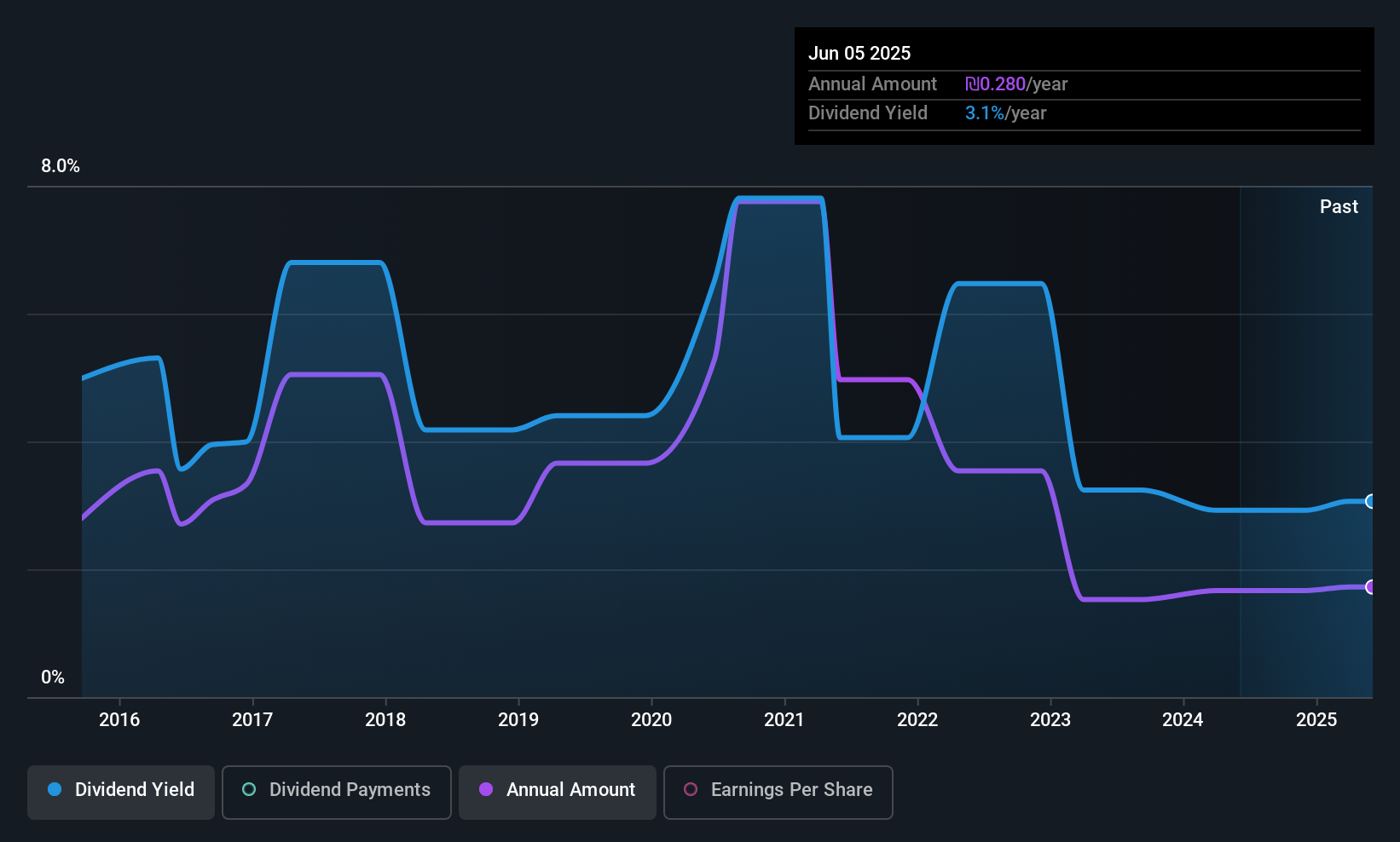Readers hoping to buy E & M Computing Ltd. (TLV:EMCO) for its dividend will need to make their move shortly, as the stock is about to trade ex-dividend. The ex-dividend date generally occurs two days before the record date, which is the day on which shareholders need to be on the company’s books in order to receive a dividend. The ex-dividend date is important as the process of settlement involves at least two full business days. So if you miss that date, you would not show up on the company’s books on the record date. Thus, you can purchase E & M Computing’s shares before the 1st of September in order to receive the dividend, which the company will pay on the 16th of September.
The company’s next dividend payment will be ₪0.025 per share, on the back of last year when the company paid a total of ₪0.28 to shareholders. Last year’s total dividend payments show that E & M Computing has a trailing yield of 3.1% on the current share price of ₪9.013. Dividends are an important source of income to many shareholders, but the health of the business is crucial to maintaining those dividends. As a result, readers should always check whether E & M Computing has been able to grow its dividends, or if the dividend might be cut.
Dividends are typically paid from company earnings. If a company pays more in dividends than it earned in profit, then the dividend could be unsustainable. E & M Computing paid out a comfortable 49% of its profit last year. Yet cash flows are even more important than profits for assessing a dividend, so we need to see if the company generated enough cash to pay its distribution. Fortunately, it paid out only 32% of its free cash flow in the past year.
It’s encouraging to see that the dividend is covered by both profit and cash flow. This generally suggests the dividend is sustainable, as long as earnings don’t drop precipitously.
Check out our latest analysis for E & M Computing
Click here to see how much of its profit E & M Computing paid out over the last 12 months.
 TASE:EMCO Historic Dividend August 28th 2025 Have Earnings And Dividends Been Growing?
TASE:EMCO Historic Dividend August 28th 2025 Have Earnings And Dividends Been Growing?
Businesses with shrinking earnings are tricky from a dividend perspective. If business enters a downturn and the dividend is cut, the company could see its value fall precipitously. E & M Computing’s earnings per share have fallen at approximately 7.0% a year over the previous five years. Ultimately, when earnings per share decline, the size of the pie from which dividends can be paid, shrinks.
Many investors will assess a company’s dividend performance by evaluating how much the dividend payments have changed over time. E & M Computing’s dividend payments per share have declined at 4.7% per year on average over the past 10 years, which is uninspiring. It’s never nice to see earnings and dividends falling, but at least management has cut the dividend rather than potentially risk the company’s health in an attempt to maintain it.
The Bottom Line
Should investors buy E & M Computing for the upcoming dividend? Earnings per share are down meaningfully, although at least the company is paying out a low and conservative percentage of both its earnings and cash flow. It’s definitely not great to see earnings falling, but at least there may be some buffer before the dividend needs to be cut. Overall, it’s not a bad combination, but we feel that there are likely more attractive dividend prospects out there.
In light of that, while E & M Computing has an appealing dividend, it’s worth knowing the risks involved with this stock. To that end, you should learn about the 3 warning signs we’ve spotted with E & M Computing (including 1 which can’t be ignored).
A common investing mistake is buying the first interesting stock you see. Here you can find a full list of high-yield dividend stocks.
Valuation is complex, but we’re here to simplify it.
Discover if E & M Computing might be undervalued or overvalued with our detailed analysis, featuring fair value estimates, potential risks, dividends, insider trades, and its financial condition.
Have feedback on this article? Concerned about the content? Get in touch with us directly. Alternatively, email editorial-team (at) simplywallst.com.
This article by Simply Wall St is general in nature. We provide commentary based on historical data and analyst forecasts only using an unbiased methodology and our articles are not intended to be financial advice. It does not constitute a recommendation to buy or sell any stock, and does not take account of your objectives, or your financial situation. We aim to bring you long-term focused analysis driven by fundamental data. Note that our analysis may not factor in the latest price-sensitive company announcements or qualitative material. Simply Wall St has no position in any stocks mentioned.

